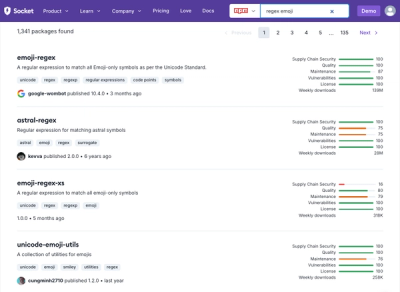
Research
Security News
Malicious npm Package Targets Solana Developers and Hijacks Funds
A malicious npm package targets Solana developers, rerouting funds in 2% of transactions to a hardcoded address.
fake-progress
Advanced tools
Simulate smooth progression easily and combine real progression and fake progression.
npm install fake-progress
var FakeProgress = require("fake-progress");
// Create the fake progress with a timeConstant of 10 seconds
// it means that :
// after 10 seconds, progress will be 0.6321 ( = 1-Math.exp(-1) )
// after 20 seconds, progress will be 0.8646 ( = 1-Math.exp(-2) )
// and so one
var p = new FakeProgress({
timeConstant : 10000,
autoStart : true
});
var exampleAsyncFunction = function(callback){
setTimeout(function(){
callback()
},30000)
};
var onEachSecond = function(){
console.log("Progress is "+(p.progress*100).toFixed(1)+" %");
};
var interval = setInterval(onEachSecond, 1000);
var onEnd = function(){
p.end();
clearInterval(interval);
console.log("Ended. Progress is "+(p.progress*100).toFixed(1)+" %")
};
exampleAsyncFunction(onEnd);
will print
Progress is 8.6 %
Progress is 17.3 %
Progress is 25.2 %
Progress is 32.3 %
...
The chart of progression over time.

Until the end is triggered, the progression is following the exponential curve, once "end" is triggered, progression goes to 100%.
In this example we will mix 3 functions, A and C are classical async functions, B is an async function with a 'real' callback.
a and c are 2 basic async functions without progress.
const a = function (cb) {
setTimeout(() => {
cb();
}, 1000);
};
const c = function (cb) {
setTimeout(() => {
cb();
}, 3000);
};
b will be an instance of an event emmiter that has a progress event
const B = function () {
EventEmitter.call(this);
let count = 0;
const self = this;
const totalCount = 30;
self.emit('start', count / totalCount);
self._intervalId = setInterval(() => {
count++;
if (count >= totalCount) {
self.emit('end', count / totalCount);
clearInterval(self._intervalId);
} else {
self.emit('progress', count / totalCount);
}
}, 100);
};
util.inherits(B, EventEmitter);
const p = new FakeProgress({});
const onEachDeciSecond = function () {
console.log('Progress is ' + (p.progress * 100).toFixed(1) + ' %');
};
onEachDeciSecond();
const interval = setInterval(onEachDeciSecond, 100);
A has no progress so we fake his progress. A succeed in 1000 ms, so we can consider 500 ms is a good timeConstant.
const aProgress = p.createSubProgress({
timeConstant: 500,
end: 0.3,
autoStart: true
});
Each time on the async chain, subProgress.stop() then call createSubProgress() to create a new subProgress.
a(err => {
if (err) {
throw (err);
}
aProgress.stop();
const bProgress = p.createSubProgress({
end: 0.8
});
const b = new B();
b.on('progress', progress => {
bProgress.setProgress(progress);
});
b.on('end', () => {
bProgress.stop();
const cProgress = p.createSubProgress({
timeConstant: 1000,
autoStart: true
});
c(() => {
cProgress.end();
onEachDeciSecond();
clearInterval(interval);
});
});
});
After each call, stop previous sub, and create a new subProgress for next request.
a(function(){
aProgress.stop();
var bProgress = p.createSubProgress({
end : 0.8
});
var b = new B();
b.on('progress', function(progress){
bProgress.setProgress(progress);
});
b.on('end', function(){
bProgress.stop();
var cProgress = p.createSubProgress({
timeConstant : 1000,
autoStart : true
});
c(function(){
cProgress.end()
onEachDeciSecond()
clearInterval(interval);
})
});
});
see source

See inside the code, documentated using JSDoc
FAQs
Fake a progress bar using an exponential progress function
We found that fake-progress demonstrated a not healthy version release cadence and project activity because the last version was released a year ago. It has 1 open source maintainer collaborating on the project.
Did you know?

Socket for GitHub automatically highlights issues in each pull request and monitors the health of all your open source dependencies. Discover the contents of your packages and block harmful activity before you install or update your dependencies.

Research
Security News
A malicious npm package targets Solana developers, rerouting funds in 2% of transactions to a hardcoded address.

Security News
Research
Socket researchers have discovered malicious npm packages targeting crypto developers, stealing credentials and wallet data using spyware delivered through typosquats of popular cryptographic libraries.

Security News
Socket's package search now displays weekly downloads for npm packages, helping developers quickly assess popularity and make more informed decisions.